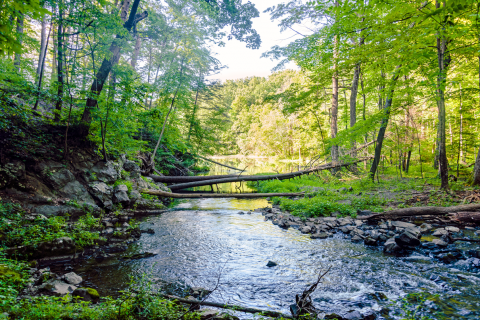Instream Wood

A field note is a report from "the field," based on observation and experience. If you have a field note you would like to share, contact, karen.bennett@unh.edu. Please note, I can't guarantee I will publish your note.
Until recently, the importance of wood in streams for fish habitat wasn't very well understood. As more is learned about the importance of large (and even small) wood in streams, landowners and foresters are asking questions. John Magee, Fish Habitat Biologist with N.H. Fish and Game, is a proponent of placing large wood in streams, but only after careful review by an experienced professional like himself who makes the final determination. Though large wood in streams may benefit fish, there are real public safety concerns.
John suggests the following stream types may be suitable for the active restoration of instream wood and woody habitat:
- Relatively small streams (channel width is less than 15 feet from bank to bank).
- Stream channel has little to no instream wood in it.
- There is no public or private infrastructure or property immediately downstream that would be damaged if added wood moved. (There are techniques to ensure that wood is "caught" by other instream wood before it gets to downstream infrastructure.)
- Wild brook trout are present in the stream. It is likely that nearly every freshwater fish species benefits directly from healthy levels of instream wood, but the strongest data for this is on wild brook trout.
- There is a pond or lake downstream. Healthy levels of instream wood help retain nutrients, such as nitrogen and phosphorous, in the stream and riparian area and thus reduce the amount of those nutrients that flow downstream into lakes and ponds.
Additional Resources
Opportunities for Cold Water Fisheries Enhancement Associated with Forestry Operations in Maine --Placing Large Wood in Streams published by the Maine Forest Service
Presentations, handouts and other resources from the Water in the Woods Workshop held at the Caroline A. Fox Research and Demonstration Forest on October 17, 2013 published by UNH Cooperative Extension
Definition of slash per New Hampshire Administrative Rules: Res 5201.01 (j)
“Slash” means, branches, bark, tops, chunks, cull logs, uprooted stumps and broken or uprooted brush and trees left on the ground after timber harvesting operations, and other cutting operations. The term does not include wood chips and small chunks of woody debris when such materials are the result of public safety activities including but not limited to highway right of way maintenance, or woody debris placed into a body of water as part of an approved fisheries habitat improvement plan, and approved by the New Hampshire department of environmental services.
